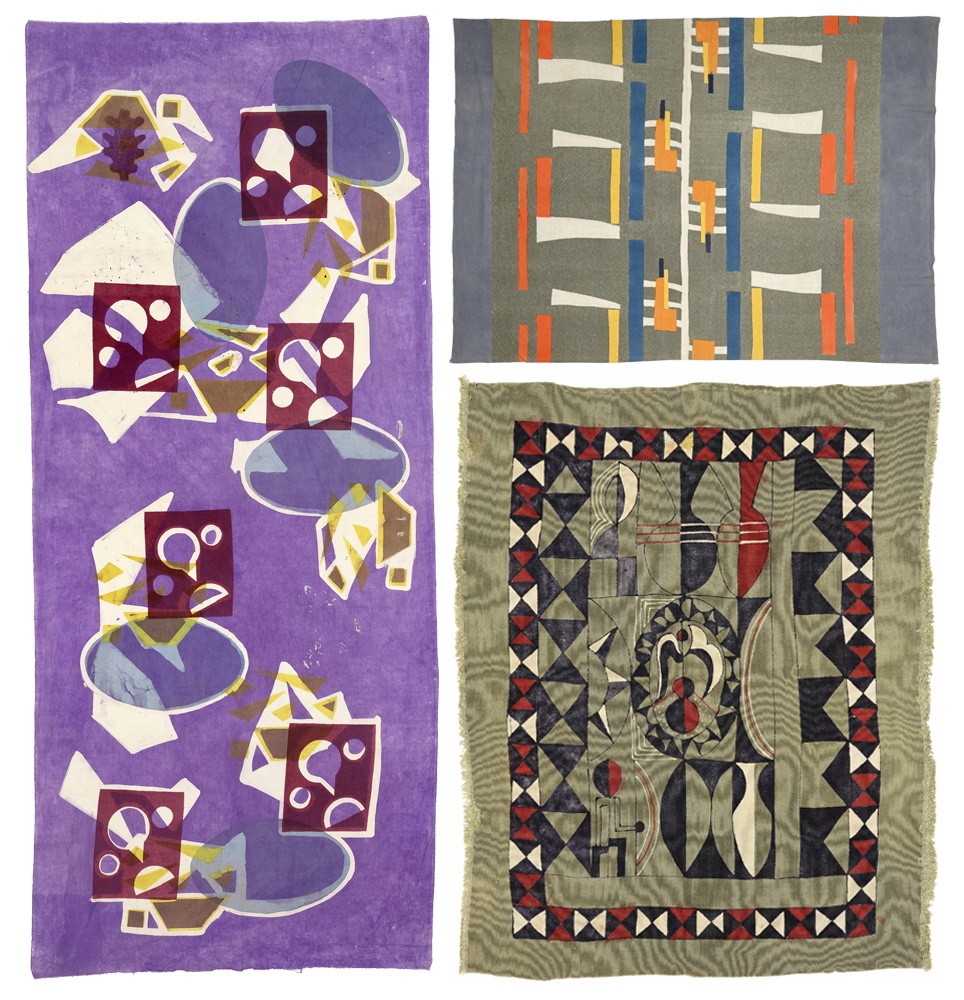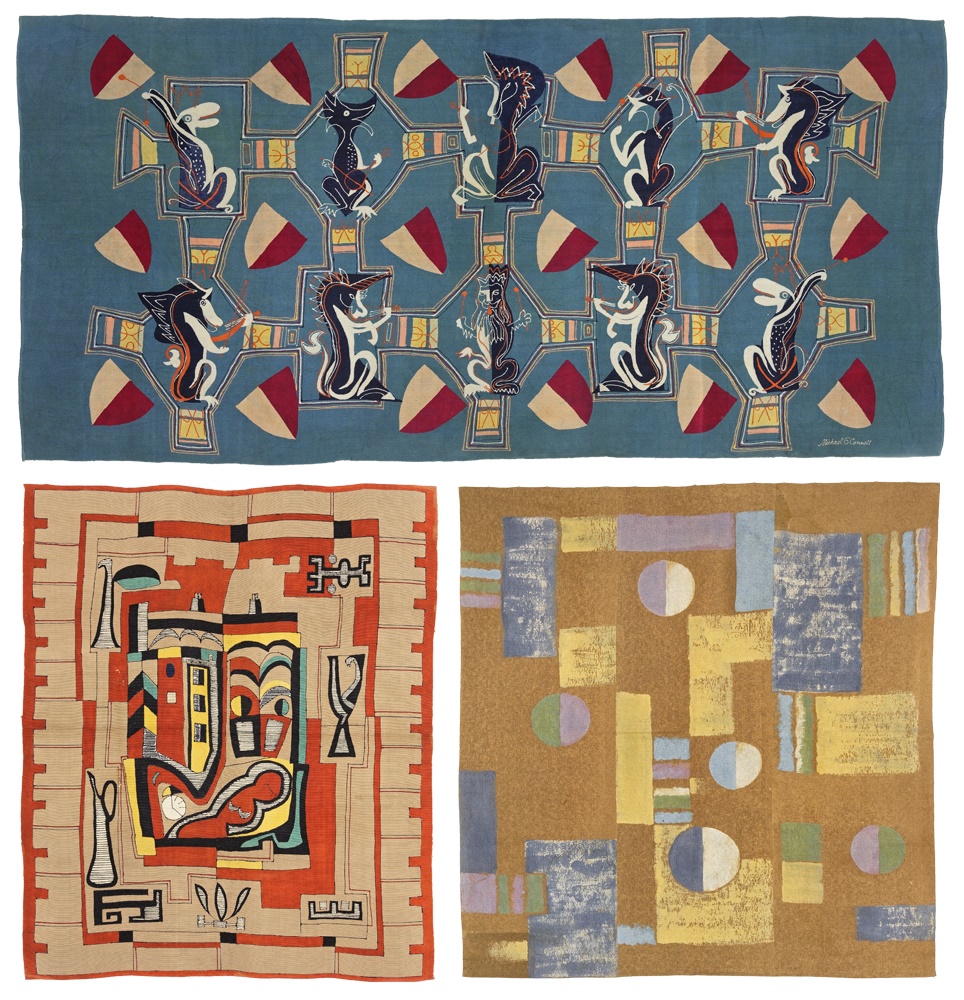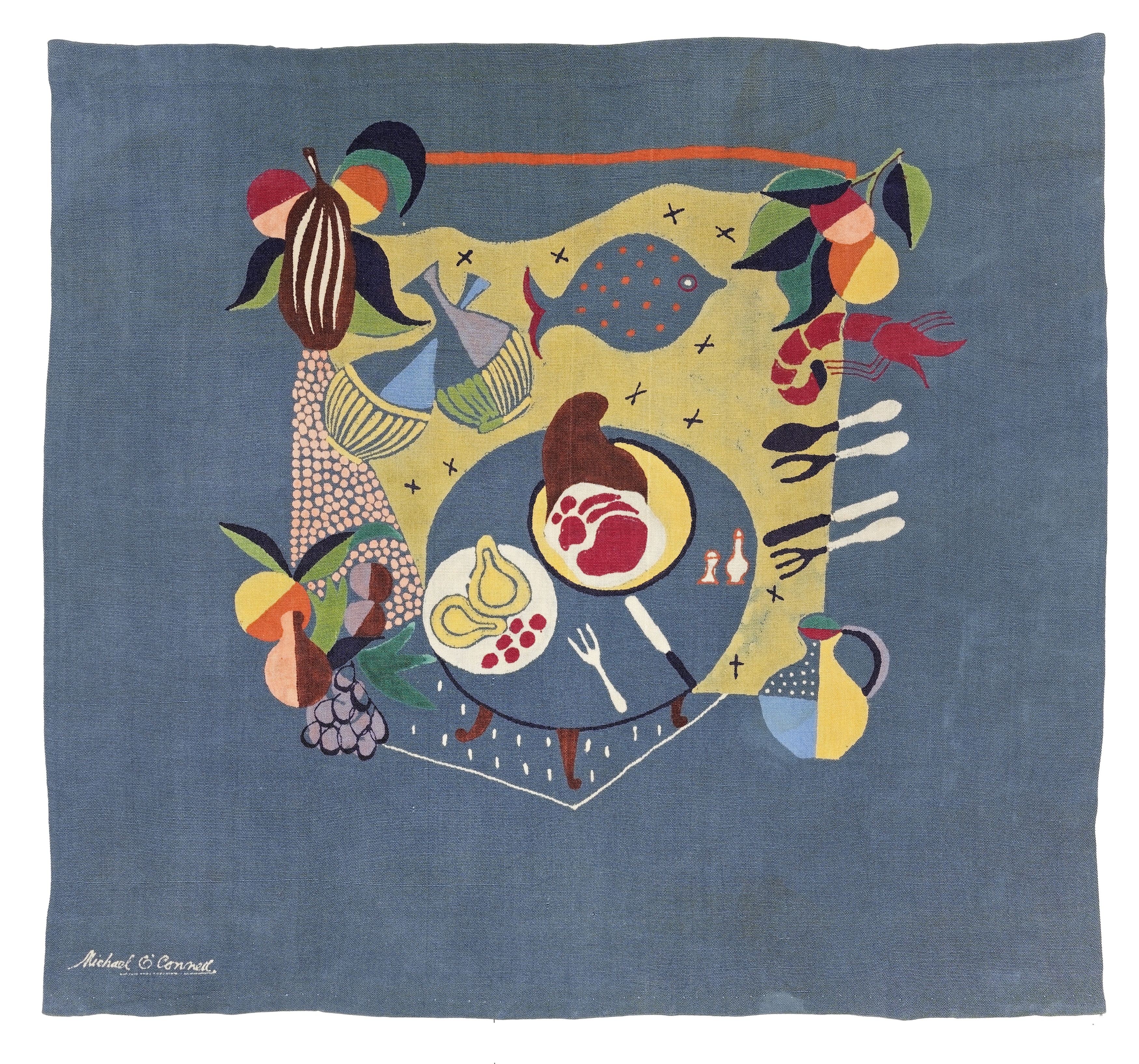

In our forthcoming auction of Design on Wednesday 18 May, we offer 24 striking post-war designs by textile artist Michael O'Connell (1898-1976).
28 April 2022
Michael O'Connell was the eldest of two sons, raised in the north of England by his mother, after the death of his father in 1900 from typhoid fever. He was educated as a lay boy at Ushaw College, a Roman Catholic seminary in County Durham, but following the outbreak of World War I, was sent to the front, in 1917, as a junior officer in an Irish regiment and was later taken prisoner of war.
After the war, Michael emigrated to Australia, originally intending to take up training in agriculture, but very soon choosing to scratch a living from art, painting watercolours and selling them in Melbourne.
By 1923, he was living in a tent on a block of land he had bought in Beaumaris on Port Philip Bay near Melbourne, where a number of painters lived, but a health inspector's arrival condemned the tent as a health risk, forcing him to pull it down. In response, he built a house, 'Barbizon', an example of early modernism in Melbourne. He built it himself, without an architect or builder, using the cheapest material he could find - concrete blocks made with sand from the site - in an open-plan cruciform design, which gave the minimum chance of the walls falling down. A local commentator observed that he 'made it for himself, out of bricks he made himself, and fitted it with furniture he made himself, and hangings he made himself! The result is perfect'. (Unfortunately, the house was lost in a bushfire in 1944). Barbizon became Michael's personal studio and a gathering place for fellow artists. His paintings were exhibited in Melbourne and were well-received - some of his works were selected for an exhibition of Victorian artists at the Empire Exhibition in Wembley in 1924-25. He also started to produce concrete garden furniture and pots - 'sculpture for the garden' - often painted and dyed, and became a member and councillor of the Arts and Crafts Society in Melbourne, where he met his wife, Ella Moody, née Evans-Vaughan (1900-1981).

Clockwise from left: Lot 477 'Squares and Ovals' paste resist on light cotton 207 x 89cm, estimate £200-300 | Lot 432 'Abstract Rectangular Blocks' paste resist on cotton, unsigned 252 x 186cm, estimate £400-600 |Lot 478 'Bird and Vases' paste resist on rayon, unsigned 175 x 140cm, estimate £300-500
In 1930, he started experimenting with linocuts, and then resolved to create a long linen frieze, 'Pandemonium'. It is not known what led to his decision to print linocuts on linen, and as a frieze rather than individually, but many of the members of the Arts and Crafts Society were interested in and working with textiles. In any case, 'Pandemonium' is one of his most significant works; it is held in the collection of the National Gallery of Australia. He used synthetic rather than the locally popular vegetable dyes, carrying out extensive research into them and becoming very knowledgeable.
In 1937, Michael and Ella moved to England, building a new home, 'The Chase', at Perry Green, near Much Hadham, Hertfordshire. It was important to Michael that from his mid-twenties onwards he never lived anywhere but in a house that he had built for himself in idyllic green surroundings.
In World War II, he served with the artillery, manning the guns at Dover, and then was moved to the Royal Ordnance as an Inspector of Dangerous Buildings at a munitions factory in Chorley, Lancashire, while Ella turned 'The Chase' into a smallholding with goats, chickens, vegetables, and an orchard, assisted by Tom Perry of Perry Green. In 1943, she joined Michael in Chorley for the birth of their son, Terence (now known as Seamus).

Clockwise from top: Lot 434 'Heraldic Figures and Emblems' paste resist on rayon, signed 180 x 390cm, estimate £1,500-2,000 | Lot 431 'Squares and Circles' paste resist on cotton, unsigned 158 x 153cm, estimate £300-500 | Lot 293 'Sun Bathing' paste resist on rayon 210 x 180cm, estimate £1,000-1,500
After the war, fabric was in short supply, but Christopher Heal (of Heal's store in London) made sure Michael was supplied with heavy rayon fabric for his wall hangings, in which he used a mixture of lino blocks and freehand painting in a resist dying technique, sometimes signing his works 'Mael'. In this he was assisted by the Sheridan sisters from Much Hadham, Betty and Iris (now Betty Clarke and Iris Dedman). There are recordings of interviews with Betty and Iris on the Michael O'Connell website and on the Museum of English Rural Life ('MERL') website.
For the 1951 Festival of Britain, he was commissioned to produce a very large wall hanging, 4 metres high by 56 metres long, in seven sections, depicting 'The Variety of British Farming'.
In the 1940s and 50s, Michael was caught up in post-war progressive initiatives to place works of art in public places, such as schools and industrial canteens - see the Leg of Ham in this sale (Lot 367, pictured below) and through to the 1970s he continued to produce hangings for sale through exhibitions and commissions, both public and private.

Lot 367 | Michael O'Connell (1898-1976) 'Leg of ham and objects on a table' paste resist on rayon, signed 165 x 175cm, estimate £800-1,200
As more kinds of fabric became available, he moved on from the heavy rayon to linen, cotton, and silk, and experimented with more complex techniques, multiple dyeings and wax resist (batik), as well as paste resist. His designs evolved through a variety of styles - reflecting the times, his travels, his interests, and the commissions he received - ranging through, among many others, the steel works in Corby, electrical circuits, heraldic motifs, history and mythology, Mexican figures, African motifs, ancient megaliths, pop art, and Saul Steinberg, whose drawings he greatly admired. He produced designs for Heal's printed fabrics, and continued to make large concrete garden pots as a sideline. In the 1970s, he experimented with macramé, batik lampshades, and smocks and skirts. He also regularly taught his techniques privately and in art schools, from Ware College, where his friend, John Tobin, ran the art department, to Taos, New Mexico. A video of him at The Chase, made by one of his students, is on the Michael O'Connell website.
In 1970, a devastating fire destroyed Michael's workshop, including most of his notebooks and records. The house was rebuilt with the help of students and friends, but it was also in this period that his eyesight began to fail. In December 1976, he was driving towards Bishop's Stortford in the morning and, with the sun in his eyes, had a motor accident in which he cracked a rib, but he feared the pain was a heart attack. Later that day he tragically took his own life at The Chase.
Michael's work is held in the collections of several museums, including the V&A, National Museums Scotland, the National Gallery of Australia, and the National Gallery of Victoria; the Festival of Britain hanging is on permanent display in the Museum of English Rural Life in Reading.
The forthcoming Design auction will be conducted live from our Stansted Mountfitchet Auction Rooms over two days on Tuesday 17 and Wednesday 18 May. For more information about the sale, please contact -
John Black
johnblack@sworder.co.uk | 01279 817778
A remarkable collection of 177 lots of rare and historic Bibles feature in our timed auction of Books, Manuscripts and Maps from 17-27 April, offering collectors, scholars and history enthusiasts a unique opportunity to own some of the most significant early English translations of the Holy Scriptures. The collection showcases centuries-old editions that played a pivotal role in shaping religious thought, language and culture.
15 April 2025
Ahead of his upcoming ‘retirement sale’ on 13–14 May, we caught up with the ever-charismatic Paul Atkinson to uncover some of the captivating stories behind the lots on offer.
11 April 2025
With styles and silhouettes endlessly evolving during the Victorian period, the continuous advancements in fashion offered women more choice and freedom regarding their attire. Sworders are delighted to present a collection of Victorian clothing in our upcoming Jewellery, Designer Handbags & Accessories sale, taking place on Wednesday 23 April.
9 April 2025